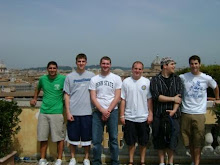
Piazza Navona is built on the sight of an ancient Rome circus called Domitian's Stadium. Some of the Stadium's arches you can still see below the church of Sant'Agnese in Agone. "Agones" means games, and this Stadium was a place where many Romans came to watch athletic contests. The stadium could hold 33,000 people. The name agone eventually changed to navone, and then to navona, giving the piazza its name. The piazza was originally a market, but was moved in 1869 to Campo de' Fiori. Besides the many restaurants, shops, and live entertainment i Piazza Navona, its main attraction is Fontana di Quattro Fiumi, meaning Fountain of the Four Rivers, built in 1651 by Bernini. Presently, it is being renovated, so besides in pictures I haven't had a great look at it. There are also two other fountains at either end of the piazza, which is shaped like a stretched oval. They were both designed by Giacomo della Porta, and completed by 1576. The fountain at the north end is called Fontana di Nettono and the one at the south end is called Fontana del Moro. Both of these fountains were altered and renovated over the years.
One very interesting thing I learned about Piazza Navona was that from 1652 to 1866, the piazza was flooded every weekend in August by stopping the fountain outlets. The rich would ride around splashing in ther carriages and others would paddle and splash around. This was done to celebrate the Pamphilj family, which was a papal family very involved with Roman politics. This is the family Pope Innocent X is part of.

No comments:
Post a Comment